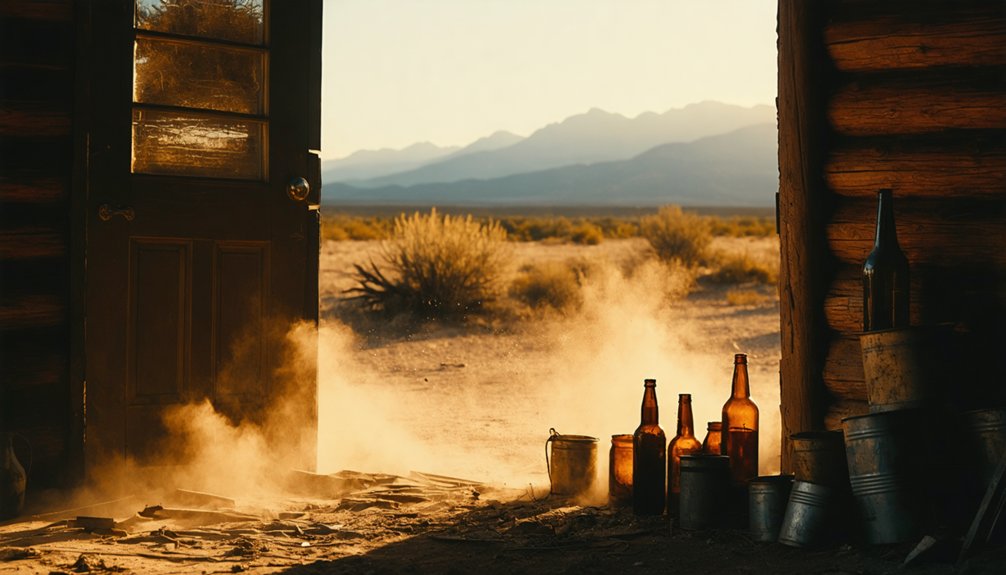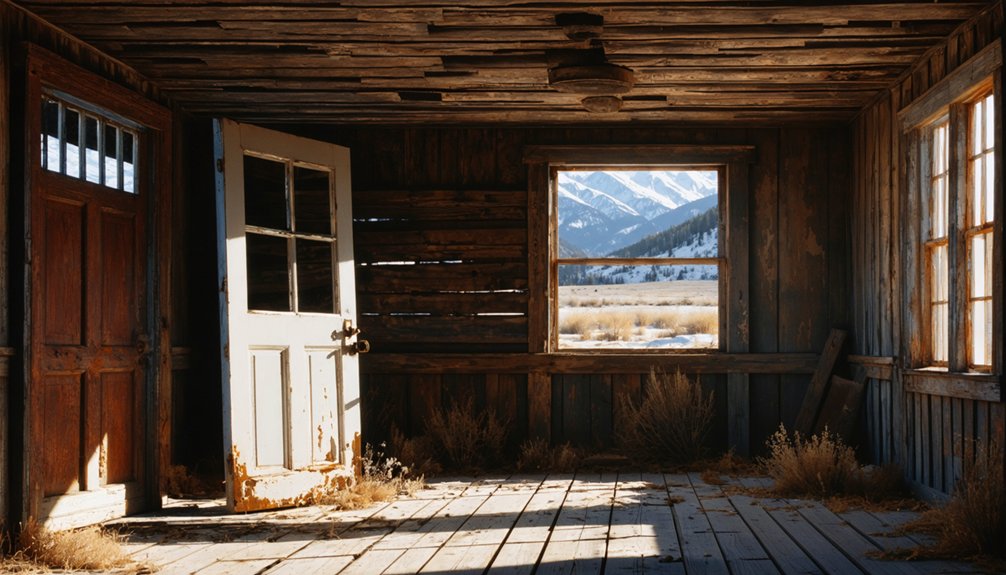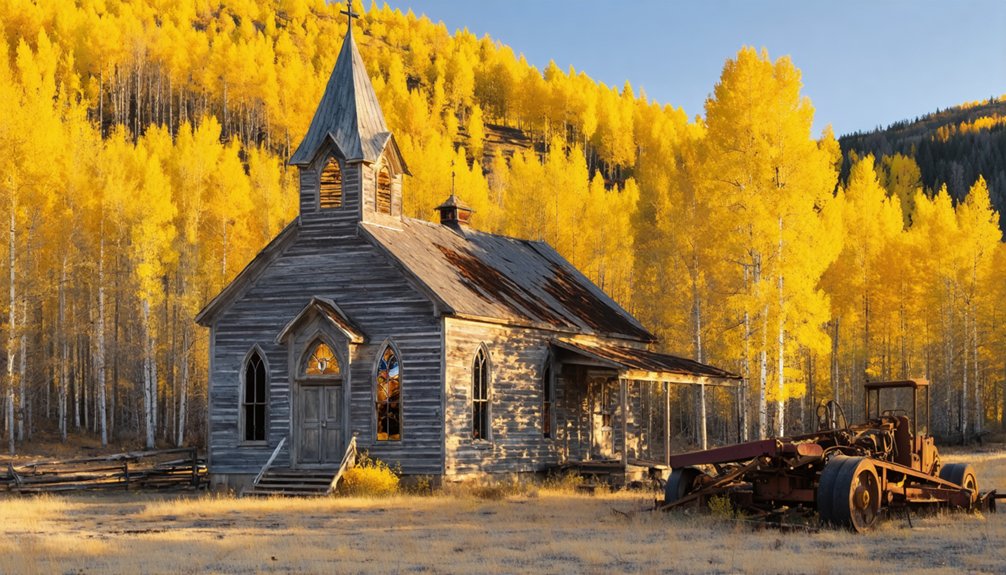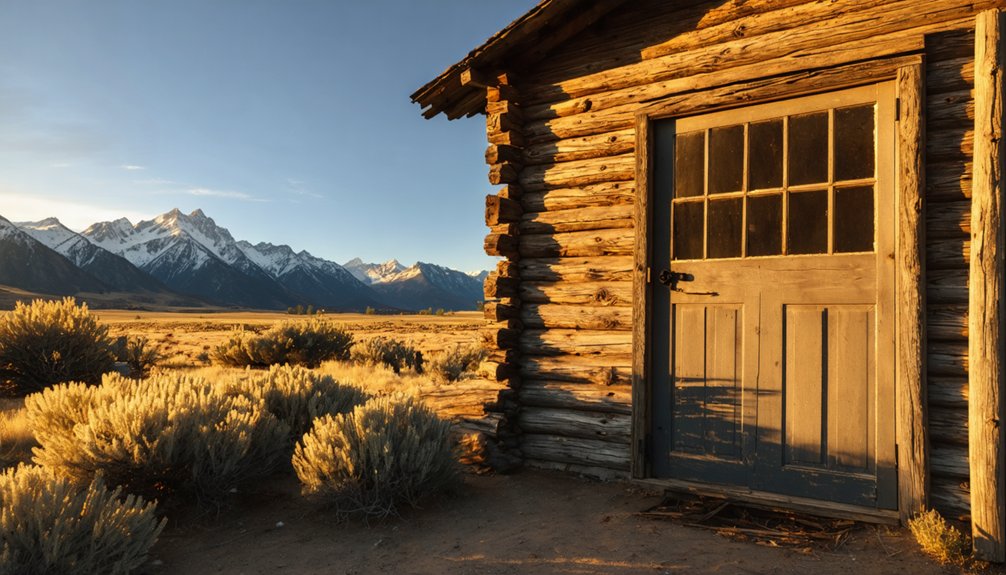You’ll find Decorah nestled in Idaho’s rugged mining country, where gold and silver miners flocked during the late 19th century boom. The ghost town sits half a mile from Landore and features preserved structures, including miners’ cabins and commercial buildings that tell stories of its vibrant past. It’s accessible by two-wheel drive roads year-round, though winter conditions can be challenging. The town’s rich mining heritage, Norwegian immigrant influences, and scattered artifacts reveal a fascinating chapter of Idaho’s frontier history.
Key Takeaways
- Decorah is a late 19th-century ghost town that emerged during Idaho’s silver and gold boom, located half a mile from Landore.
- The town features preserved structures, including original miners’ cabins and commercial buildings that showcase its vibrant mining heritage.
- Decorah is accessible via two-wheel drive roads year-round, though winter conditions may limit exploration opportunities.
- The site was supported by 75 local businesses during its peak and was part of the productive Coeur d’Alene mining district.
- Visitors can explore mining artifacts, historic buildings, and experience the town’s Norwegian-influenced cultural remnants through preserved structures.
The Rise of Idaho’s Fun Mining Town
While many Western mining towns sprouted up overnight during America’s mineral rushes, Decorah emerged as one of Idaho’s promising camps during the late 19th century silver and gold boom.
You’d have found prospectors flocking to the area, drawn by impressive gold prices of $20 per ounce and silver at $1.10 per ounce.
The economic impact was substantial as mining techniques evolved from simple placer mining to more sophisticated operations. The abundant mineral wealth of the region helped establish the Coeur d’Alene district as one of the world’s largest silver producers.
The region’s rich deposits of lead, zinc, and copper, alongside precious metals, attracted serious mining companies.
You’ll appreciate how the arrival of railroads and advanced smelting methods from Colorado transformed Decorah from a seasonal camp into a bustling mining district.
The town’s growth mirrored Idaho’s broader mineral industry expansion, which established hundreds of productive mining districts across the state.
Life and Leisure in Early Decorah
You’d find Decorah’s miners seeking entertainment at the town’s bustling saloons and gambling halls after their grueling shifts underground.
The lush Driftless Area landscape provided a stunning backdrop for miners as they made their way between work sites and social gatherings.
Between work periods, miners gathered for communal meals at boarding houses where they’d share stories and build camaraderie that helped them cope with the isolation of frontier life.
Social activities often centered around weekend dances and musical performances, where the chiefly male mining population would travel to neighboring settlements hoping to meet potential marriage partners.
The miners, many of whom came from Norwegian immigrant backgrounds, brought their cultural traditions and memories from the old country to their new western home.
Miners’ Entertainment After Hours
Despite the scarcity of direct historical records from Decorah, Idaho’s mining era, the town’s after-hours entertainment likely mirrored that of other 19th-century Western mining communities.
You’d have found the saloons bustling with activity, as miners gathered to try their luck at gambling games like cards and dice. Live music often filled these establishments, with fiddles and banjos creating an energetic atmosphere for dancing and socializing. Some miners even displayed their glowing mineral specimens in these venues, creating an otherworldly ambiance like that seen in modern black light exhibits.
When you weren’t at the saloon, you might’ve joined storytelling circles where tales of rich strikes and near misses became local legend. Physical activities kept spirits high, with impromptu sports matches and shooting competitions bringing the community together. Many miners would make the journey from 6,000 to 8,500 feet in elevation to reach these entertainment venues after their shifts.
While brothels and “social houses” operated in most mining towns, they provided more than just companionship – they were often gathering spots where miners could escape the day’s grueling work.
Social Life Between Shifts
Since historical records about Decorah, Idaho’s social activities remain scarce, much of what we comprehend comes from similar mining settlements of the era.
What’s known suggests that mining friendships formed the backbone of daily social interactions, with workers supporting each other through the demanding nature of their profession.
Community gatherings likely centered around practical needs, with miners sharing resources and helping during emergencies.
You’d find social bonds strengthened through cooperative efforts like sharing tools and expertise between shifts.
While specific details about Decorah’s entertainment venues haven’t survived, mining towns typically saw workers congregating at local establishments during off-hours, where they’d share stories, play cards, or simply decompress from their underground labor.
These gatherings served as vital outlets for maintaining morale and fostering camaraderie in the harsh realities of frontier mining life.
Notable Structures and Physical Remains
The mining ghost towns of Decorah, Landore, and Garnet Town showcase a remarkable collection of preserved structures from Idaho’s mining era.
You’ll find Landore’s distinctive 1904 brick smelter chimney standing tall against the mountain backdrop, while original miners’ cabins dot the landscape across all three settlements. Like Silver City’s ghost town status, these settlements reflect the decline of mining operations in the region. The architectural features reflect the region’s mining heritage through simple, utilitarian designs using local wood and brick materials. Idaho’s arid climate helps maintain these historic structures in remarkably good condition.
At Decorah, which served as the area’s social hub, you can explore remaining commercial buildings that once housed the town’s bustling activities.
Decorah’s preserved storefronts stand as silent witnesses to the vibrant community life that once flourished in this mining town.
Nearby Garnet Town offers views of three tumbled cabin remains, while scattered mining artifacts, from rusted cans to abandoned ore processing equipment, tell stories of daily life.
The towns’ layouts along creek beds reveal how settlers maximized natural resources.
Mining Culture and Community Impact
After long days of grueling physical labor in Decorah’s mines, you’d find workers seeking entertainment at local establishments where music, drink, and camaraderie helped ease their hardships.
The miners endured challenging conditions in the underground copper mine as they extracted valuable ore from the mountainside.
You’d have witnessed the development of tight-knit support networks among mining families, who shared resources and looked after one another during tough times.
The bonds formed in this challenging environment created a resilient community spirit that helped sustain Decorah’s residents through the boom-and-bust cycles of Idaho’s mining era.
Entertainment For Hard Labor
Mining communities like Decorah recognized the vital importance of entertainment and social gatherings to counterbalance their grueling work conditions. You’d find miners congregating at outhouses and ruins after their shifts, sharing stories of their underground experiences through communal storytelling.
These informal gatherings helped preserve their oral traditions and mining rituals while providing psychological relief from the day’s dangers.
The surrounding wilderness offered outdoor escapes through hiking and fishing, while community events often centered around mining infrastructure like aerial tramways. With 75 local businesses supporting the miners during peak times, entertainment and social venues thrived throughout the town.
Today, you can experience this rich heritage through mining museums and interpretation centers, where interactive exhibits and virtual lectures bring these stories to life.
These institutions serve as modern entertainment venues while preserving the legacy of how miners found solace and community amid their challenging work lives.
Local Community Support Network
Beyond typical entertainment venues, Decorah emerged as an essential social hub that strengthened bonds between miners from neighboring towns like Landore and Helena.
The town’s role in fostering community connections went far beyond simple recreation, creating lasting social bonds that helped miners cope with their demanding work lives. Following the tradition of Idaho’s mining heritage, many residents helped preserve artifacts and stories that documented the cultural interactions of the era.
You’ll find that Decorah’s mining legacy is preserved through:
- Original buildings that stand as evidence of the town’s role in supporting local mining operations
- Historical records showing how the town facilitated cultural exchange between different mining communities
- Evidence of economic support systems that helped sustain neighboring mining towns
The town’s infrastructure, though modest compared to larger mining settlements, provided vital support services that maintained the region’s social fabric during the height of Idaho’s mining era.
Exploring the Ghost Town Today

Today’s visitors to Decorah can explore a well-preserved slice of Idaho’s mining heritage, where several original buildings still stand against the backdrop of rugged Adams County terrain.
You’ll find this former “fun town” just half a mile down Indian Creek from Landore, accessible by two-wheel drive roads.
While exploring the remaining structures, you’ll encounter echoes of ghost town legends and mining folklore amid the quiet mountain setting.
The site offers year-round access, though winter brings snow to these high-elevation ruins.
Pack supplies and maps, as services are limited.
When investigating nearby Landore and Garnet Town sites, respect property boundaries and watch for structural hazards in aging buildings.
The surrounding creek valleys provide scenic hiking opportunities, making Decorah an ideal destination for both history buffs and outdoor enthusiasts.
Seasonal Guide for Ghost Town Visitors
While planning your visit to Decorah’s remnants, you’ll need to carefully consider seasonal conditions that affect both access and safety. The high-desert climate brings extreme variations that impact visitor safety throughout the year, from summer wildfires to winter snowpack.
For ideal seasonal activities, consider these critical timing factors:
- Summer visits require early morning starts to avoid afternoon heat and thunderstorms.
- Fall offers the most stable conditions but demands wildfire awareness.
- Winter access is severely limited by snow, while spring brings muddy, unstable ground.
You’ll need to pack appropriate gear for rapid weather changes regardless of season.
Connecting With Nearby Historical Sites

Situated within a rich network of preserved mining settlements, Decorah connects visitors to numerous historically significant sites across central Idaho.
You’ll find rich historical connections at nearby Bayhorse Ghost Town, where preserved mining structures and interpretive trails await your exploration. For educational opportunities, visit the Yankee Fork Gold Dredge to see one of America’s best-preserved gold mining operations.
Make Wallace your next stop to dive deeper into Idaho’s silver mining heritage through its museums and guided tours.
You can also link your visit to the charcoal kilns near Leadore or venture to Silver City’s 70 original buildings.
The Lost Gold Trails Loop and Peaks to Craters Scenic Byway offer convenient routes to connect these historic mining sites while experiencing Idaho’s rugged backcountry beauty.
Preservation Efforts and Current Status
Despite extensive research into Idaho’s ghost town preservation efforts, limited records exist regarding formal protection initiatives specifically for Decorah. While other Idaho ghost towns receive U.S. Forest Service management and preservation support, Decorah’s current status remains unclear.
Common preservation challenges include balancing historical protection with economic development pressures.
Preserving historic ghost towns requires careful navigation between maintaining cultural heritage and accommodating modern economic growth needs.
Key aspects of successful ghost town preservation include:
- Federal and state-certified boards providing education and protection
- Community engagement through public meetings and planning
- Sustainable funding sources for structural maintenance
You’ll find similar preservation frameworks in nearby ghost towns, where informational signage and guided tours help maintain historical significance.
Without an active preservation commission or detailed records for Decorah, any protection efforts likely remain informal or small-scale, potentially managed through broader regional historic site initiatives.
Photography and Sightseeing Tips

Planning to photograph Decorah’s ghostly remnants requires careful preparation and the right equipment.
You’ll need a reliable DSLR or mirrorless camera, along with wide-angle and prime lenses to capture both sweeping landscapes and intricate details. Don’t forget your tripod for low-light shots and a cleaning kit to protect your gear from dust.
When composing your ghost town shots, start with establishing frames of Decorah’s key structures. Focus on compelling details like weathered wood textures, rusted metal, and vintage artifacts.
Try black and white photography to enhance the town’s haunting atmosphere. For unique perspectives, experiment with light painting at night or HDR techniques to capture interiors through windows.
Remember to secure necessary permissions before exploring, and always respect any posted restrictions while documenting this piece of Idaho history.
Frequently Asked Questions
Are There Any Documented Paranormal Activities or Ghost Sightings in Decorah?
You won’t find any officially documented ghostly encounters or spectral sightings in Decorah, though the town’s mining history and abandoned status make it ripe for paranormal investigation and local legends.
What Items of Value Have Been Discovered by Metal Detectorists?
Like prospectors of old, you’ll find gold coins, rings, and gemstone jewelry during relic hunting. Metal detectorists have unearthed valuable 1800s currency, pocket watches, and personal trinkets in riverbed sediments.
Did Any Famous Outlaws or Notable Historical Figures Visit Decorah?
You won’t find any confirmed outlaw legends or historical visitors at this location. While it served as a fun spot for local miners, there’s no evidence of famous personalities ever stopping by.
Were There Any Major Disasters or Accidents in Decorah’s Mining History?
While local mining accidents happened, Decorah’s operations weren’t hit by major disasters. You’ll find more significant tragedy nearby, like the 1972 Sunshine Mine fire that claimed 91 lives in Kellogg.
What Native American Tribes Originally Inhabited the Area Before Decorah’s Establishment?
You’ll find the area was primarily inhabited by Shoshone culture and Bannock history, particularly the Tukudika (Sheep Eater) subgroup who used these mountain regions for seasonal hunting and gathering activities.
References
- https://history.idaho.gov/wp-content/uploads/2018/08/0064.pdf
- https://idaho-forged.com/idahos-ghost-towns-eerie-yet-approachable/
- https://visitidaho.org/things-to-do/ghost-towns-mining-history/
- https://www.ghosttowns.com/states/id/landore.html
- https://visitdecorah.com/decorah-impact-crater/
- https://en.wikipedia.org/wiki/Decorah
- https://www.youtube.com/watch?v=6WgkZpygBzY
- https://www.idahogeology.org/Uploads/Data/ISMIR/1921_ISMIR.pdf
- https://www.idahogeology.org/pub/Staff_Reports/1997/S-97-14.pdf
- https://history.idaho.gov/wp-content/uploads/2018/08/0009.pdf



